Does Good Posture Really Matter?
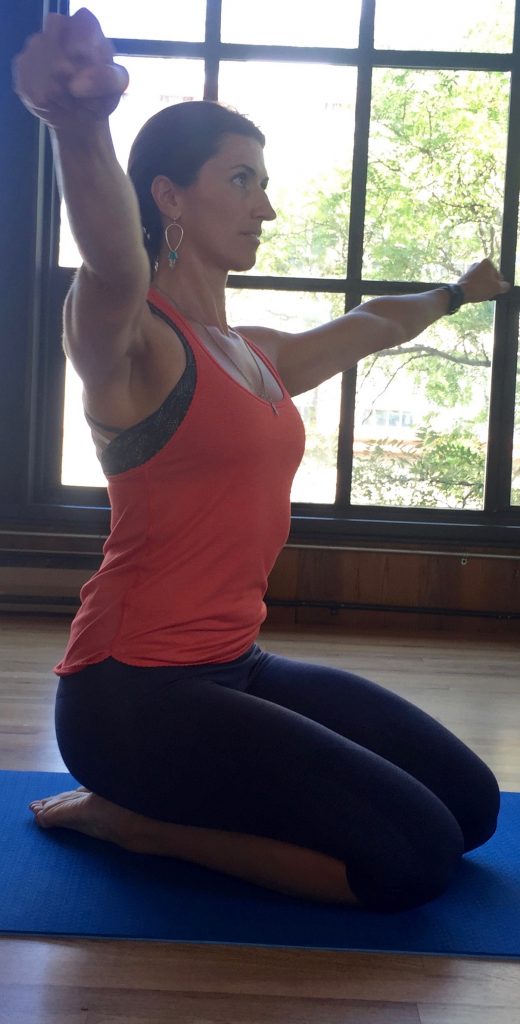
You probably heard it a hundred times as a teenager:
“Sit up straight!”
“Fix your posture!”
“Don’t slouch!”
Good posture has long been the mission of doting mothers and fictitiously strict schoolteachers. And they are right to get on us about sitting a little taller.
Posture is by far one of the simplest ways you can improve your mood, outlook, energy, and health. Science teaches us that the posture you hold can dictate the hormones and neurotransmitters you exude! Plus, with so many of us sitting at a desk all day we need it more than ever. Even standing desks create opportunities to slouch.
By maintaining healthy posture, whether sitting, standing, or walking you provide your body with the alignment it needs to decrease abnormal wear and tear on joints, reduce the stress on ligaments that hold your joints and spine together, and allow your muscles to be used properly—preventing fatigue, headaches, and chronic neck or back pain.
From an aesthetic viewpoint, good posture is attractive and studies show you’ll likely have more positive interactions with the people around you as you exude confidence through your body language.
If you’re struggling to maintain good posture I have some simple tips, exercises, and stretches that can help you begin to establish the 3 components of good posture:
- Muscular Endurance
- Mobility
- Practice
•Muscular Endurance is developed by regularly working the muscles of the back, spine, shoulders, core, and pelvis. The strength of the trunk is critical to being able to hold the natural curves of the pelvis and spine while the muscles of the rotator cuff work to seat the shoulder blades in an optimal position on the back.
•Mobility requires both flexibility and stability of the joints and ligaments. Without proper range of motion you will not be able to access the alignment needed to sit up straight, draw the shoulder blades down, tilt the pelvis, open across the chest or lengthen the cervical neck.
•Practice allows for a new way of being and behaving to become ingrained as a habit — something done automatically. The practice of creating and maintaining good posture is possible with just a few minutes of practice each day.
There are several strength and mobility tools you can use as practice for better posture in a matter of minutes — but I’m going to start by giving you my favorite simple tips:
Daily Tips
- Find Tadasana:
Tadasana, Mountain Pose, is a standing pose in yoga. It’s a foundation upon which all other postures are built. I often teach my clients to “Find Tadasana” in all other poses, exercises, and in daily life. It’s a simple reminder of how to achieve healthy posture during their yoga practice, weight training session, sitting at work, or even while cooking dinner and doing chores. Here’s how to “Find Tadasana” and improve your posture in just 60 seconds:
- Begin standing with feet hip-width apart, toes pointing forward with inner and outer edges of feet parallel. Allow arms to relax at your sides.
- Take a few rounds of breath to connect your mind and body.
- On an exhale press your feet into the ground creating equal connection through balls of the feet, pinky edges, and heels. Toes will be light, not gripping.
- Inhale as you tighten the front of your thighs (quadriceps) and draw your inner thighs back (think about inner thighs rolling in & back without the knees caving in)
- Exhale and curl tailbone down toward the heels to find a neutral pelvic alignment without losing the connection to inner thighs. This will simultaneously help you draw your low belly in.
- Inhale to lengthen up the spine and sides of the torso. Visualize space being created in between each vertebrae and rib as you inhale.
- Stay tall through the spine. Exhale, allow the shoulder blades to slide down the back and open across the chest and collarbones.
- Inhale to lengthen the neck & reach the crown of your head to the sky. Chin & eyes will be level so that front & back of the neck are equal length.
- Hold Tadasana for 3-5 breaths. Then relax completely and start again.
- Create Consistency:
Set an alarm to go off every 15 minutes for 1 hour. Every time the alarm goes off, find Tadasana. Do this several times per day.
- Behave As If:
Move around as if you had a glass of water (or a delicious glass of red wine, as I tell my clients) on top of your head – you’ll automatically stand up taller and move more deliberately.
Stretches:
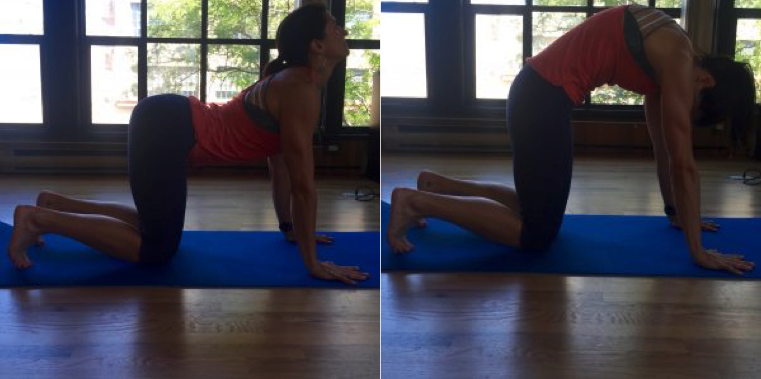
Cat/Cow
Creates mobility within the spine while stretching the muscles of the back, chest, and abdomen.
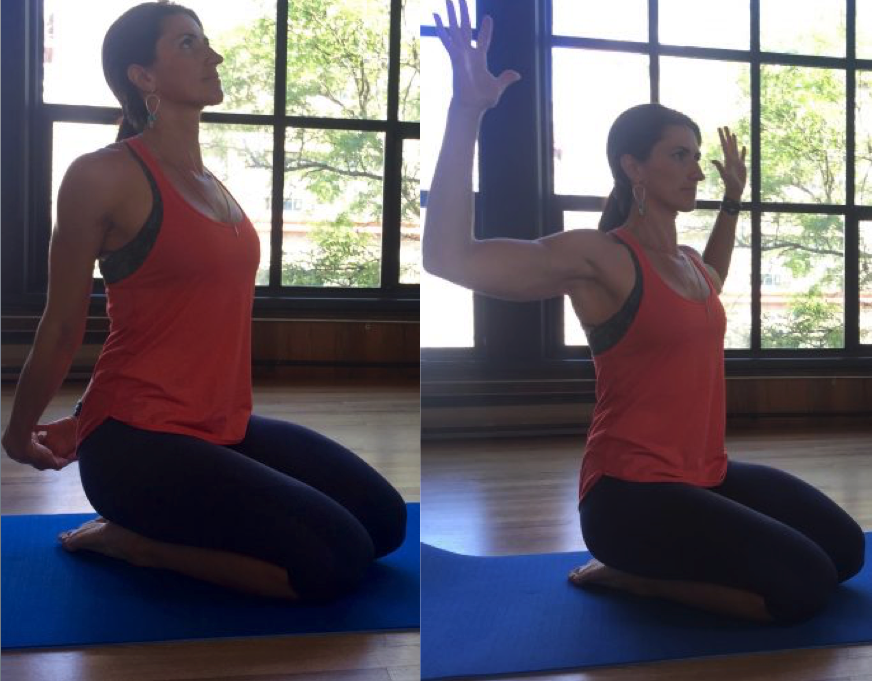
Goal Post into Chest Opener
This combo move engages the back and draws the scapula down the back while the chest and front of the shoulders receive an opening stretch.
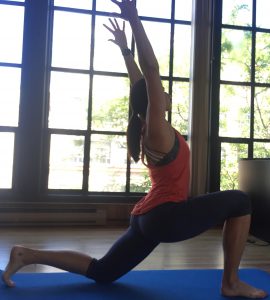
Low Lunge
Low lunge helps to open the entire front side of the body releasing tension in the pelvis and thighs. You can find this stretch and 8 others that offer a complete hip and low back series in my free 9 Super Stretches video.
Exercises:
 Plank
Plank
Plank is basically Tadasana but in the pushup position. It builds the exact kind of muscular endurance you’ll need to carry yourself with good posture every day.
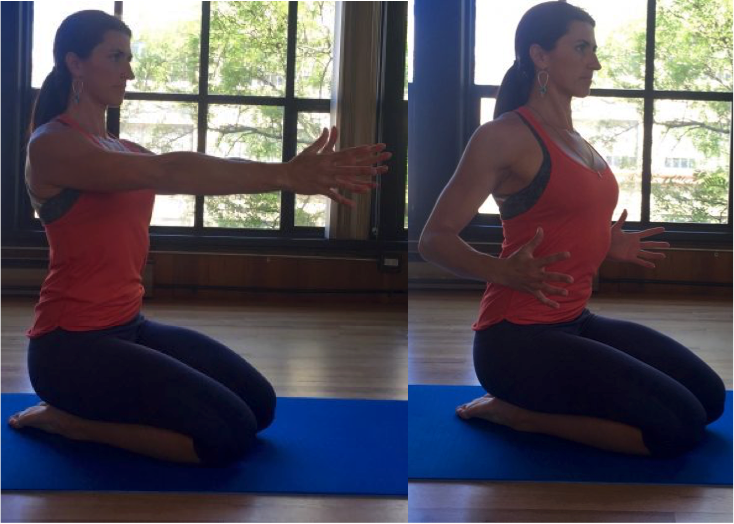
Row
The muscles between the shoulder blades often get neglected or over stretched from excessive hunching and slouching. Various versions of the Row can help you strengthen these muscles and improve range of motion in the shoulder blades.
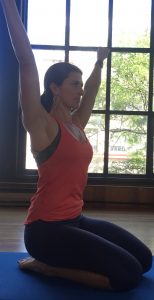
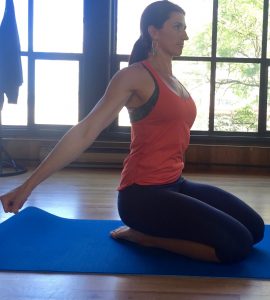
Arm Circles
Arm circles are an excellent way to create mobility and stability in the shoulder girdle and scapula. By manipulating the speed and size of the arm circles, you can easily target all 3 components of good posture.
Click here to follow along as I “Find Tadasana” then incorporate the stretches and exercises. By doing these simple steps daily, you will not only be able to access perfect posture no matter where you are or what you’re doing, but you will experience a sense of lightness, connectivity, energetic flow, and confidence as you move through your day!
In Love & Gratitude,

Missi Holt
